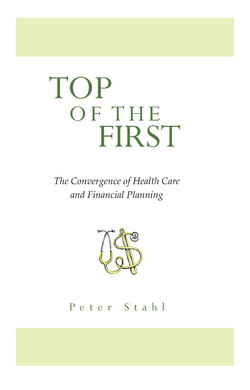Top of the First 2016

Реклама. ООО «ЛитРес», ИНН: 7719571260.
Оглавление
Peter Stahl. Top of the First 2016
Introduction
An Overview of Medicare
Calculating the Cost
Understanding Tax Control
Timing Your Medicare Enrollment
Custodial Care
Play Ball
Отрывок из книги
1Health and Retirement: Planning for the Great Unknown; A Merrill Lynch study conducted in partnership with Age Wave; 2014.
2The annual Mercer Workplace Survey of retirement plan participants June 2013.
.....
Medicare Part A receives its funding from a couple of sources. The first source is a payroll tax of 2.9%. The employee and the employer split the tax evenly each paying 1.45%. Beginning in 2014, the Patient Protection Affordable Care Act introduced two additional taxes for couples earning over $250,000 or single filers earning over $200,000. The first is an added .9% tax on earned income. The second is a 3.8% tax on net investment income.2 If your income is close to these levels, discuss this tax with your financial advisor and tax professional. If you are able to manage income flows, capital gains, and utilize tax favored investments to keep you below these income thresholds, the tax savings are meaningful.
Since the funding for Part A is provided by the aforementioned taxes, there is no direct cost for this insurance when one becomes eligible and enrolls. Most people are eligible and enroll in Medicare Part A when they reach age 65. The most common way to know that you are eligible for “free” Part A coverage is if you qualify for Social Security benefits. There are special considerations for those who need Part A due to a disability prior to age 65. You may wish to delay your enrollment in Part A beyond age 65 if you have creditable coverage from an employer health insurance plan. This is most common when one desires to continue funding into a Health Savings Account. This strategy will be discussed in chapter 4.
.....